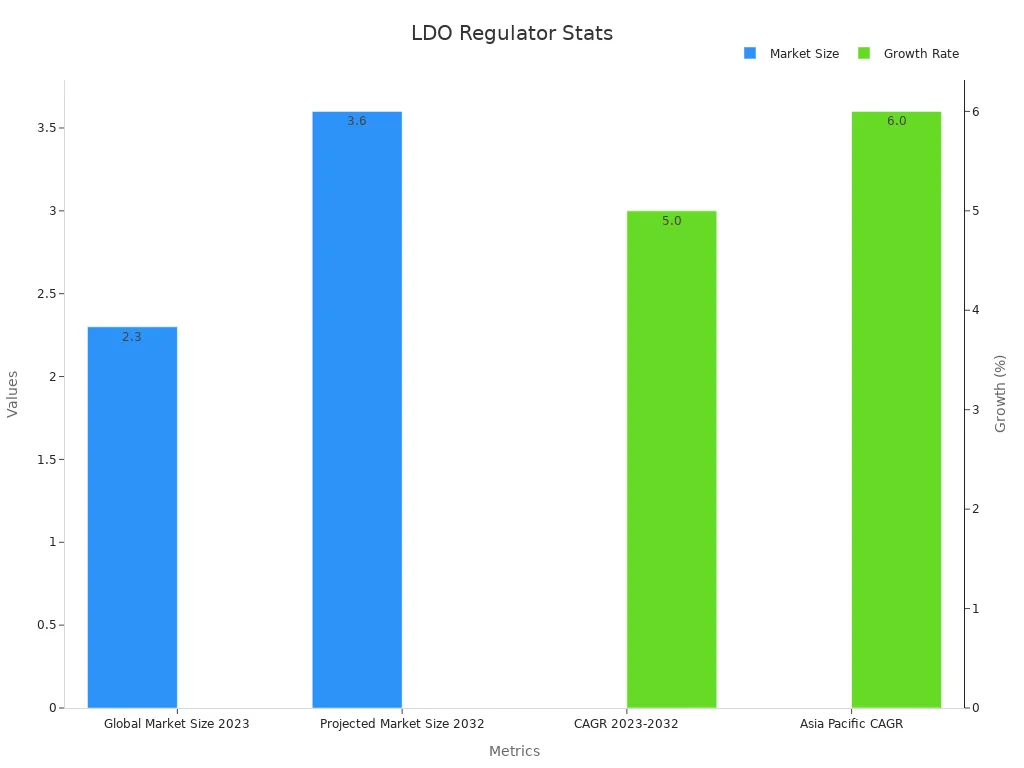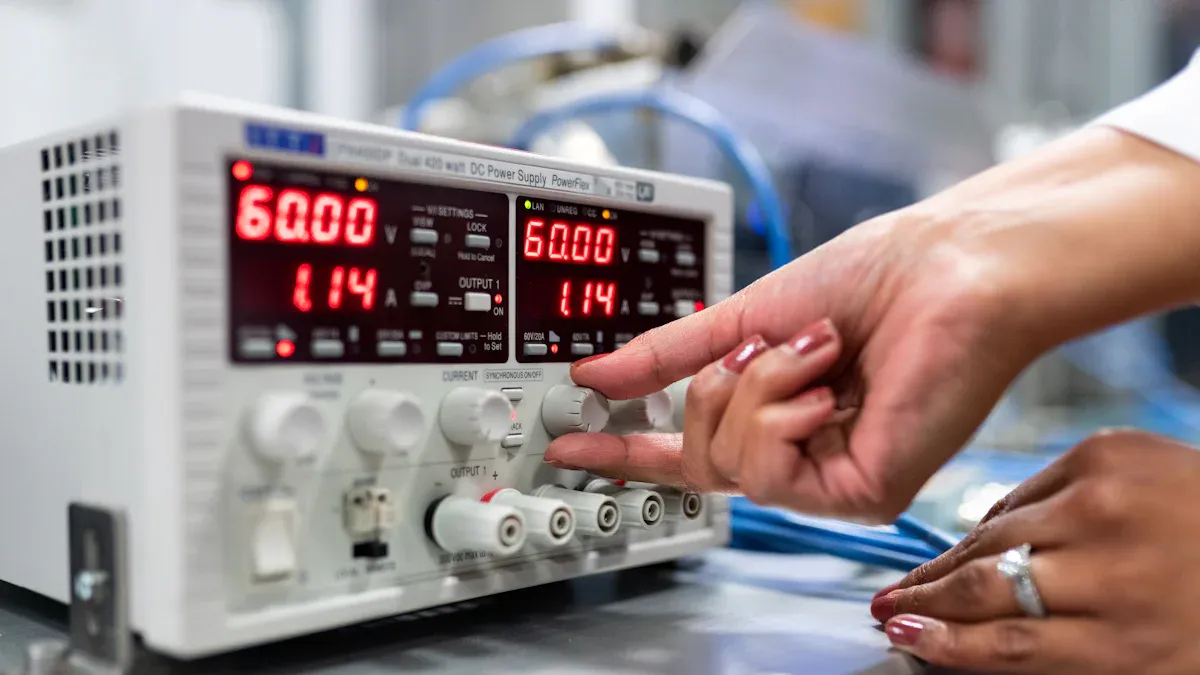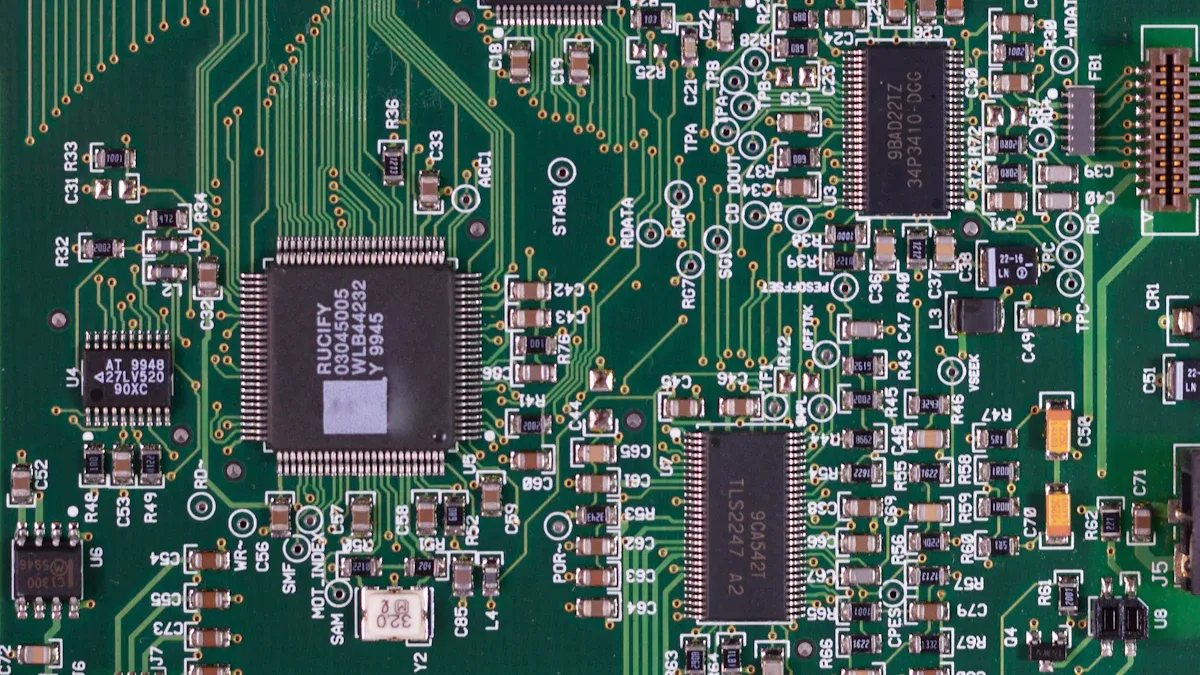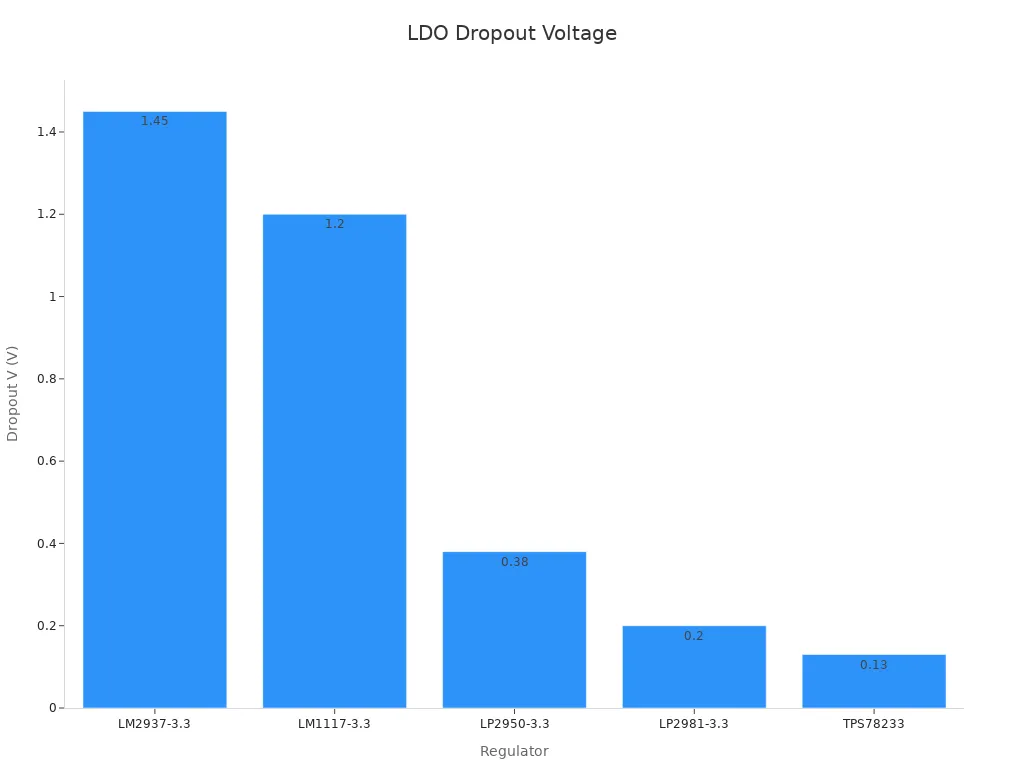What Is an LDO Linear Regulator Chip and How Does It Work

An LDO Linear Regulator chip helps you keep electronic devices running smoothly by providing a steady voltage, even when the input voltage is only slightly higher than the output. "Low dropout" means the chip can work with a small voltage difference, which saves power and reduces heat. You benefit from simple operation: the chip uses a pass transistor and feedback to control the output voltage. LDOs play a key role in smartphones, wearables, and automotive systems, supporting a global market that reached $2.3 billion in 2023.

Key Takeaways
LDO Linear Regulator chips keep electronic devices running by providing steady voltage with very little difference between input and output voltage, saving power and reducing heat.
These chips have simple designs, low noise, fast response, and built-in protections, making them ideal for battery-powered and sensitive devices like smartphones, wearables, and audio circuits.
Inside an LDO, a pass transistor and feedback system work together to maintain stable output voltage even when input voltage or load changes.
Choosing the right LDO means checking dropout voltage, output current, noise level, and quiescent current to match your device’s needs and improve efficiency and battery life.
LDOs work best for low to moderate current devices needing quiet, stable power; for high power or efficiency, other regulators like buck converters may be better.
LDO Linear Regulator Chip Basics

What Is an LDO
You use an LDO Linear Regulator chip to keep your electronic circuits safe and steady. This chip takes a higher input voltage and brings it down to a lower, stable output voltage. The "LDO" stands for "Low Dropout," which means the chip can still work well even when the input voltage is only a little higher than the output voltage. This feature helps you save power and reduce heat, especially in battery-powered devices.
Technical literature describes LDOs as essential for modern electronics, such as smartphones, wearables, and automotive systems. These chips work well in systems-on-chip (SoC) environments, where you need fast response, low noise, and high accuracy. You can find LDO Linear Regulator chips in many products because they offer reliable voltage control and protect sensitive components.
Key Features
When you choose an LDO Linear Regulator chip, you look for several important features. These features help you decide if the chip fits your project:
Low Dropout Voltage: The chip keeps the output voltage steady even when the input is just a bit higher. This is important for battery-powered devices, where every bit of energy counts.
Simple Design: You do not need many extra parts to use an LDO. This makes your circuit easier to build and saves space.
Low Noise: The chip produces very little electrical noise. This helps protect sensitive parts of your circuit, like radio receivers or sensors.
Fast Transient Response: The chip reacts quickly when the load changes, so your device stays stable.
High Power Supply Ripple Rejection (PSRR): The chip blocks unwanted noise from the power supply, which is important in audio and RF circuits.
Low Quiescent Current: The chip uses very little current to operate, which helps your battery last longer.
Tip: Many LDO Linear Regulator chips include built-in protections, such as thermal shutdown and short-circuit protection. These features keep your devices safe in tough conditions.
You can see some of the main performance metrics for LDO Linear Regulator chips in the table below:
Performance Metric | Description | Typical Value / Note |
|---|---|---|
Output Voltage Accuracy | How close the output stays to the set value | ±5% total (often better) |
Line Regulation | How much the output changes when the input changes | Very low percentage, depends on design |
Load Regulation | How much the output changes when the load changes | Very low percentage, important for stable devices |
Dropout Voltage | Minimum difference between input and output | 200-300mV at max current |
Ground (Quiescent) Current | How much current the chip itself uses | Very low, especially in PMOS designs |
PSRR | How well the chip blocks noise from the input | High PSRR is critical for audio and RF |
Transient Response | How fast the chip reacts to sudden changes | Fast response keeps output steady |
Self-Noise | Noise the chip itself creates | Low self-noise is best for sensitive circuits |
You find LDO Linear Regulator chips in many industries. For example, automotive LDOs work in harsh environments, from –40°C to +150°C, and include features like watchdogs and early warning systems. Leading companies design chips with ultra-low quiescent current, high accuracy, and strong protections. These features make LDOs a top choice for battery-powered devices, medical equipment, and advanced automotive systems.
How It Works

Pass Transistor and Feedback
Inside every LDO Linear Regulator chip, you find a smart system that keeps your voltage steady. The main parts include a pass transistor, a feedback circuit, and a reference voltage source. The pass transistor acts like a gatekeeper. It controls how much current flows from the input to the output. You can think of it as a valve that opens or closes to keep the output voltage just right.
The reference voltage comes from a special circuit called a band gap reference. This circuit creates a stable voltage, even if the temperature or input voltage changes. The feedback circuit checks the output voltage using a resistor divider. It compares this voltage to the reference voltage. If the output drifts away from the target, the error amplifier sends a signal to the pass transistor to adjust its resistance. This closed-loop system keeps your output voltage stable, even when the load or input voltage changes.
You can see how these parts work together in the table below. It shows the main components and their roles:
Component | Function |
|---|---|
Pass Transistor | Controls current flow, adjusts output voltage |
Band Gap Reference | Provides a stable reference voltage (Vref) |
Error Amplifier | Compares output to Vref, sends correction signal |
Feedback Network | Senses output voltage, feeds it back to the error amplifier |
When you use an LDO Linear Regulator chip, the pass transistor can be a MOSFET or a bipolar transistor. At low load currents, the pass transistor acts like a high-impedance current source. This helps block noise and keeps the output steady. As the load increases, the transistor’s output impedance drops. This can make the output voltage less stable and reduce the chip’s ability to block noise. For example, tests show that the pass transistor’s gain can drop by over 20 dB as the load current doubles from 100 mA to 200 mA. At heavy loads, the transistor enters a region where it cannot control the voltage as well, so you may see more voltage changes or noise.
Note: The feedback loop in an LDO Linear Regulator chip works fast to correct any changes. This quick response helps your devices stay safe and reliable.
Dropout Voltage
Dropout voltage is a key feature of any LDO Linear Regulator chip. It tells you the smallest difference needed between the input and output voltages for the chip to work properly. If the input voltage drops too close to the output, the pass transistor cannot keep the output steady. A lower dropout voltage means you can use more of your battery’s energy and reduce wasted power.
You can compare different LDO chips by looking at their dropout voltages, output currents, and quiescent currents. The table below shows some popular 3.3 V LDO regulators:
Regulator | Max Output Current (Iout) | Dropout Voltage (Vdo) | Quiescent Current (Iq) |
|---|---|---|---|
LM2937-3.3 | 500 mA | 1.45 V | 10 mA |
LM1117-3.3 | 800 mA | 1.2 V | 5 mA |
LP2950-3.3 | 100 mA | 0.38 V | 75 µA |
LP2981-3.3 | 100 mA | 0.2 V | 0.6 mA |
TPS78233 | 150 mA | 0.13 V | 500 nA |
You can also see the differences in dropout voltage in the chart below:

A lower dropout voltage helps you save energy and keep your device running longer. For example, some advanced LDOs have dropout voltages as low as 19.3 mV at 50 mA load current. This allows stable output voltage and better power efficiency, which is important for battery-powered devices and SoC (System on Chip) applications. Research shows that when you use an LDO with a dropout voltage of 140 mV, you get low power consumption and strong voltage regulation. Lower dropout voltage also means less heat and better chip stability.
The table below shows how dropout voltage affects chip performance:
Dropout Voltage (mV) | Power Consumption (mW) | Line Regulation (mV/V) | Load Regulation (mV/mA) | Technology | Chip Area (µm²) |
|---|---|---|---|---|---|
140 | 1.48 | 1.0 | 0.41 | 0.18 µm CMOS | 27 x 34 |
32.06 | 1.3593 | 0.13 µm CMOS | Two-stage OTA, PMOS pass transistor | Lower dropout voltage reduces power loss, enhances voltage stability |
Tip: Always check the dropout voltage when you choose an LDO Linear Regulator chip. A lower value means better efficiency and longer battery life for your device.
Pros and Cons
Advantages
You get many benefits when you use an LDO Linear Regulator chip in your project. Here are some of the main advantages:
Simple Circuit Design: You do not need many extra parts. This makes your circuit easy to build and saves space on your board.
Low Noise Output: LDOs produce very little electrical noise. You protect sensitive parts, like sensors or audio circuits, from interference.
Fast Response: The chip reacts quickly to changes in load. Your device stays stable even when the power demand shifts.
Low Dropout Voltage: You can use almost all the energy from your battery. This helps your device run longer and stay cooler.
High Power Supply Ripple Rejection (PSRR): LDOs block unwanted noise from the power source. You get cleaner power for your circuits.
Built-in Protections: Many LDOs include features like thermal shutdown and short-circuit protection. You keep your devices safe from damage.
Tip: If you want a reliable and quiet power supply for your sensitive electronics, an LDO is often the best choice.
Limitations
You should also know about the limits of LDO Linear Regulator chips. These points help you decide if an LDO fits your needs:
Lower Efficiency at High Voltage Differences: If the input voltage is much higher than the output, the chip wastes more power as heat. Your device may get hot and lose energy.
Limited Output Current: LDOs cannot handle very high currents. You may need a different regulator for power-hungry devices.
Heat Generation: When the chip drops a lot of voltage, it creates heat. You might need extra cooling for your circuit.
No Voltage Boost: LDOs only lower voltage. If you need to raise voltage, you must use a different type of regulator.
Size Limits for High Power: For large loads, the chip and its heat sink can take up more space.
Advantage | Limitation |
|---|---|
Simple design | Lower efficiency at high Vin-Vout |
Low noise | Limited output current |
Fast response | Heat generation |
High PSRR | No voltage boost |
Built-in protections | Size limits for high power |
Remember: Always match the LDO’s strengths to your project’s needs. This helps you get the best results for your design.
Applications and Selection
Typical Uses
You find LDO Linear Regulator chips in many everyday devices. These chips help your electronics work safely and efficiently. Here are some common uses:
Smartphones and tablets use LDOs to keep their processors and memory running at the right voltage.
Wearable gadgets, like fitness trackers and smartwatches, rely on LDOs for long battery life and stable operation.
IoT devices, such as smart sensors and home automation products, need LDOs to manage power in small spaces.
Flat-screen TVs, gaming consoles, and audio equipment use LDOs to deliver clean power and reduce noise.
Audio circuits and sensitive analog devices depend on LDOs for low noise and high power supply rejection, which keeps signals clear.
The number of IoT devices keeps growing and may reach over 29 billion by 2030. Many of these devices, like smart health monitors and asset trackers, use LDOs with ultra-low quiescent current to save battery power. For example, the STLQ020 series from STMicroelectronics is popular in smart home sensors because it uses very little energy.
Tip: If you design a device that needs quiet, stable power in a small space, you will likely use an LDO Linear Regulator chip.
Choosing an LDO
When you pick an LDO for your project, you need to look at several important factors. Each factor helps you match the chip to your device’s needs:
Input and Output Voltage: Make sure the chip can handle your input voltage and provide the output voltage you want.
Dropout Voltage: Choose a chip with a low dropout voltage if you want better efficiency, especially for battery-powered devices.
Quiescent Current: Look for low quiescent current to extend battery life in portable gadgets.
Output Current Capability: Check that the chip can supply enough current for your device, both at normal and peak loads.
Noise and PSRR: Pick a chip with low noise and high power supply rejection if you use it in audio or sensitive analog circuits.
Load and Line Regulation: Good regulation keeps your output voltage steady, even when the load or input changes.
Temperature Performance: Make sure the chip works well in the temperature range your device will face.
You can also choose between different types of LDOs:
LDO Type | Best For |
|---|---|
Fixed Output | Simple, single-voltage designs |
Programmable | Devices needing multiple power modes |
Ultra-low Dropout | High efficiency, noisy input supplies |
Low Noise/High PSRR | Audio and sensitive analog circuits |
Capless | Space-constrained devices |
High Current | Devices with large power needs |
Performance charts, like PSRR versus frequency or noise density, help you compare chips. These charts show how well the chip blocks noise and how much noise it adds to your circuit. Always balance your needs for efficiency, noise, and stability when you select an LDO.
Note: No single LDO fits every project. You should weigh each feature and trade-off to find the best match for your design.
LDOs vs Other Regulators
Comparison
You often need to choose between an LDO linear regulator and other types of voltage regulators, such as buck converters. Each type has strengths and weaknesses. LDOs stand out for their low noise and simple design. You can use them with just a few extra parts. Buck converters, on the other hand, need more components like inductors and can be more complex to set up.
LDOs give you very clean power. For example, some LDOs, like the ROHM BUxxJA3DG-C, produce output noise as low as 55 µVrms, which is about 40% lower than similar low-noise LDOs. Some advanced LDOs even reach below 4 µVrms. Buck converters create more noise because of their switching action. This noise can affect sensitive circuits.
You can see the main differences in the table below:
Feature | LDO Characteristics | Buck Converter Characteristics |
|---|---|---|
Complexity | Simple, few parts | Needs inductor, more complex |
Noise | Very low, ideal for analog/RF | Higher, includes switching ripple |
PSRR | High (good at blocking input noise) | Lower, depends on filtering |
Efficiency | Lower with big voltage drops | High (up to 95%) |
Output Current | Best for low to moderate (<500mA) | Best for high current (>500mA) |
Quiescent Current | Very low, good for standby | Higher |
LDOs also have a high Power Supply Rejection Ratio (PSRR). For example, an LDO with a PSRR of 55 dB at 1 MHz can reduce a 1 mV input ripple to about 17.78 µV at the output. This makes LDOs a top choice for noise-sensitive applications.
When to Use LDOs
You should use an LDO when your project needs quiet, stable power and the input voltage is only a little higher than the output. LDOs work best in these situations:
You build audio, RF, or sensor circuits that need low noise.
Your device runs on batteries and you want to use as much battery life as possible.
You need a simple, compact power solution.
Your load current stays below 500 mA.
Tip: LDOs shine in wearables, IoT sensors, and medical devices where every bit of power and every microvolt of noise matters.
If your project needs to handle high currents or large voltage drops, or if you want the highest efficiency, a buck converter may fit better. Buck converters work well in power-hungry devices like laptops or motor controllers. You can mix both types in one design—use LDOs for sensitive parts and buck converters for high-power sections. This way, you get the best of both worlds.
You now understand how an LDO Linear Regulator chip keeps your devices safe and efficient. Choose an LDO when you need low noise and simple design. Always check the dropout voltage, output current, and noise level before you decide. Think about your device’s needs and compare the benefits and limits. Careful selection helps you get the best performance for your project.
FAQ
What does "low dropout" mean in an LDO regulator?
"Low dropout" means the chip can keep the output voltage steady even when the input voltage is only a little higher than the output. You save power and reduce heat with this feature.
Can you use an LDO for high current devices?
You should not use an LDO for very high current devices. Most LDOs work best with low to moderate currents. If your device needs a lot of power, try a switching regulator.
Why do you need low noise in some circuits?
Low noise keeps your sensitive circuits, like audio or sensors, working well. You avoid unwanted signals and interference. LDOs help you get clean power for these parts.
How do you know which LDO to choose?
You look at your device’s voltage, current, and noise needs. Check the dropout voltage, quiescent current, and protection features. Pick the LDO that matches your project’s requirements.
Do LDOs waste energy?
LDOs can waste energy if the input voltage is much higher than the output. The extra voltage turns into heat. You get better efficiency when the input and output voltages are close.
See Also
Understanding The Basics Of Low-Dropout Regulator Chips
How Programmable Logic Chips Function And Their Uses
Exploring Current-Loop Transmitter Chips And Their Operation
A Guide To IC Line Drivers And Their Electronic Role
Power Supply Chips Explained: Functions And Importance In Electronics
